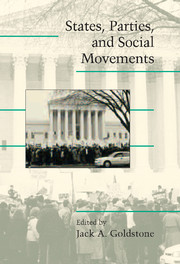Book contents
INTRODUCTION: BRIDGING INSTITUTIONALIZED AND NONINSTITUTIONALIZED POLITICS
Published online by Cambridge University Press: 26 February 2010
Summary
Some years ago, Craig Jenkins and Bert Klandermans (1995, p. 3) stated that “Surprisingly little attention has been paid to the interaction between social movements and the state.” If that statement was at all valid then, it certainly is no longer valid now. The last half-decade has seen an enormous outpouring of work on the mutual influences between social movements and the state, ranging over such topics as framing protest issues (Gamson and Meyer 1996), repression (Kurzman 1996; Rasler 1996), movement outcomes (Dalton 1995; Misztal and Jenkins 1995), and, most commonly, political opportunity structures (Kriesi 1995; McAdam, McCarthy, and Zald 1996; Tarrow 1996).
Nonetheless, there has been a persistent tendency to see this interaction as distinct from normal institutionalized politics occurring through voting, lobbying, political parties, legislatures, courts, and elected leaders. As Jenkins and Klandermans state this distinction: “[S]ocial movements … constitute a potential rival to the political representation system” (1995, p. 5). This separation of movement politics from institutionalized politics was concretized in Charles Tilly's (1978) enormously influential schema presenting social movements as “challengers” seeking to enter the institutionalized world of “polity members” who have routinized access to the levers of power. It was strongly reinforced by William Gamson's (1990) depiction of social movements as “outsider” groups whose challenges succeed, in one sense, as such groups become recognized actors in institutional politics. As Mary Fainsod Katzenstein (1998, p. 195) expressed this view: “Students of social movements commonly associate institutionalization with demobilization.… Social movements … are necessarily extrainstitutional.”
- Type
- Chapter
- Information
- States, Parties, and Social Movements , pp. 1 - 24Publisher: Cambridge University PressPrint publication year: 2003
- 64
- Cited by



